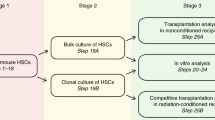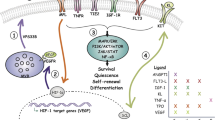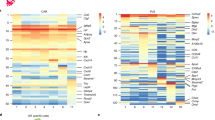Summary:
In vitro cobblestone area (CA)-forming cell (CAFC) and in vivo (short-term and competitive repopulation) assays demonstrate that a qualitative hierarchy exists within the Hoechst-33342-defined side population (SP) in murine bone marrow (BM). Consistent with and extending previous studies, we demonstrate that (i) hematopoietic activity found in whole BM (WBM) is concentrated within the SP, rather than the non-SP (NSP); and (ii) within the SP, those cells that more strongly efflux the dye (lower SP, LSP) are qualitatively different from those that less strongly efflux the dye (upper SP, USP). Qualitative differences are highlighted by evidence that (i) CA derived from LSP CAFC persist in culture significantly longer than CA derived from USP CAFC; (ii) short-term, multilineage repopulation of lethally irradiated mice by LSP cells is more rapid than that in mice receiving USP, NSP, whole SP (WSP), or WBM cells and (iii) LSP cells out-compete USP cells in the multilineage hematopoietic repopulation of lethally irradiated recipients. These data suggest that LSP cells are of higher quality than USP cells and potentially provide a means by which qualitative changes in primitive hematopoietic progenitors occurring naturally with aging, or clinically as a consequence of therapeutic manipulation, can be assessed.
This is a preview of subscription content, access via your institution
Access options
Subscribe to this journal
Receive 12 print issues and online access
$259.00 per year
only $21.58 per issue
Buy this article
- Purchase on Springer Link
- Instant access to full article PDF
Prices may be subject to local taxes which are calculated during checkout





Similar content being viewed by others
References
Bunting KD . ABC transporters as phenotypic markers and functional regulators of stem cells. Stem Cells 2002; 20: 11–20.
Goodell MA, Brose K, Paradis G et al. Isolation and functional properties of murine hematopoietic stem cells that are replicating in vivo. J Exp Med 1996; 183: 1797–1806.
Goodell MA, Rosenzweig M, Kim H et al. Dye efflux studies suggest that hematopoietic stem cells expressing low or undetectable levels of CD34 antigen exist in multiple species. Nat Med 1997; 3: 1337–1345.
Storms RW, Goodell MA, Fisher A et al. Hoechst dye efflux reveals a novel CD7(+)CD34(–) lymphoid progenitor in human umbilical cord blood. Blood 2000; 96: 2125–2133.
Uchida N, Fujisaki T, Eaves AC et al. Transplantable hematopoietic stem cells in human fetal liver have a CD34(+) side population (SP) phenotype. J Clin Invest 2001; 108: 1071–1077.
Guo Y, Follo M, Geiger K et al. Side-population cells from different precursor compartments. J Hematother Stem Cell Res 2003; 12: 71–82.
Montanaro F, Liadaki K, Schienda J et al. Demystifying SP cell purification: viability, yield, and phenotype are defined by isolation parameters. Exp Cell Res 2004; 298: 144–154.
Asakura A, Rudnicki MA . Side population cells from diverse adult tissues are capable of in vitro hematopoietic differentiation. Exp Hematol 2002; 30: 1339–1345.
Summer R, Kotton DN, Sun X et al. Side population cells and Bcrp1 expression in lung. Am J Physiol Lung Cell Mol Physiol 2003; 285: L97–L104.
Alvi AJ, Clayton H, Joshi C et al. Functional and molecular characterisation of mammary side population cells. Breast Cancer Res 2003; 5: R1–R8.
Asakura A, Seale P, Girgis-Gabardo A et al. Myogenic specification of side population cells in skeletal muscle. J Cell Biol 2002; 159: 123–134.
Lechner A, Leech CA, Abraham EJ et al. Nestin-positive progenitor cells derived from adult human pancreatic islets of Langerhans contain side population (SP) cells defined by expression of the ABCG2 (BCRP1) ATP-binding cassette transporter. Biochem Biophys Res Commun 2002; 293: 670–674.
Murayama A, Matsuzaki Y, Kawaguchi A et al. Flow cytometric analysis of neural stem cells in the developing and adult mouse brain. J Neurosci Res 2002; 69: 837–847.
Wulf GG, Wang RY, Kuehnle I et al. A leukemic stem cell with intrinsic drug efflux capacity in acute myeloid leukemia. Blood 2001; 98: 1166–1173.
Bunting KD, Zhou S, Lu T et al. Enforced P-glycoprotein pump function in murine bone marrow cells results in expansion of side population stem cells in vitro and repopulating cells in vivo. Blood 2000; 96: 902–909.
Zhou S, Schuetz JD, Bunting KD et al. The ABC transporter Bcrp1/ABCG2 is expressed in a wide variety of stem cells and is a molecular determinant of the side-population phenotype. Nat Med 2001; 7: 1028–1034.
Zhou S, Morris JJ, Barnes Y et al. Bcrp1 gene expression is required for normal numbers of side population stem cells in mice, and confers relative protection to mitoxantrone in hematopoietic cells in vivo. Proc Natl Acad Sci USA 2002; 99: 12339–12344.
Kim M, Turnquist H, Jackson J et al. The multidrug resistance transporter ABCG2 (breast cancer resistance protein 1) effluxes Hoechst 33342 and is overexpressed in hematopoietic stem cells. Clin Cancer Res 2002; 8: 22–28.
Scharenberg CW, Harkey MA, Torok-Storb B . The ABCG2 transporter is an efficient Hoechst 33342 efflux pump and is preferentially expressed by immature human hematopoietic progenitors. Blood 2002; 99: 507–512.
Uchida N, Dykstra B, Lyons K et al. ABC transporter activities of murine hematopoietic stem cells vary according to their developmental and activation status. Blood 2004; 103: 4487–4495.
Parmar K, Sauk-Schubert C, Burdick D et al. Sca(+)CD34(−) murine side population cells are highly enriched for primitive stem cells. Exp Hematol 2003; 31: 244–250.
Pearce DJ, Ridler CM, Simpson C et al. Multiparameter analysis of murine bone marrow side population cells. Blood 2004; 103: 2541–2546.
Matsuzaki Y, Kinjo K, Mulligan RC et al. Unexpectedly efficient homing capacity of purified murine hematopoietic stem cells. Immunity 2004; 20: 87–93.
Ploemacher RE, van der Sluijs JP, Voerman JS et al. An in vitro limiting-dilution assay of long-term repopulating hematopoietic stem cells in the mouse. Blood 1989; 74: 2755–2763.
Harrison DE, Astle CM . Loss of stem cell repopulating ability upon transplantation. Effects of donor age, cell number, and transplantation procedure. J Exp Med 1982; 156: 1767–1779.
Harrison DE, Astle CM, DeLaittre JA . Loss of proliferative capacity in immunohemopoietic stem cells caused by serial transplantation rather than aging. J Exp Med 1978; 147: 1526–1531.
Jackson JD, Zhou G, Kuszynski CA et al. Induction of chimerism in mice using human MHC class I-mismatched Hoechst 33342 side population donor stem cells. Cell Transplant 2002; 11: 779–785.
Neben S, Anklesaria P, Greenberger J et al. Quantitation of murine hematopoietic stem cells in vitro by limiting dilution analysis of cobblestone area formation on a clonal stromal cell line. Exp Hematol 1993; 21: 438–443.
Uchida N, Dykstra B, Lyons KJ et al. Different in vivo repopulating activities of purified hematopoietic stem cells before and after being stimulated to divide in vitro with the same kinetics. Exp Hematol 2003; 31: 1338–1347.
Mazini L, Wunder E, Sovalat H et al. Mature accessory cells influence long-term growth of human hematopoietic progenitors on a murine stromal cell feeder layer. Stem Cells 1998; 16: 404–412.
Mazini L, Wunder E, Sovalat H et al. Human accessory cells have a humoral bystander effect on CAFC growing on murine feeder. J Hematother Stem Cell Res 2000; 9: 749–757.
Olesen G, Tonder H, Palshof T et al. Peripheral blood accessory cells modulate committed colony-forming units but not 5-week cobblestone-area-forming cell outgrowth from CD34+ cells. Eur J Haematol 2002; 68: 65–72.
Wineman J, Moore K, Lemischka I et al. Functional heterogeneity of the hematopoietic microenvironment: rare stromal elements maintain long-term repopulating stem cells. Blood 1996; 87: 4082–4090.
Lajtha LG . Kinetics of haemopoiesis. Br J Radiol 1971; 44: 234.
Ivanova NB, Dimos JT, Schaniel C et al. A stem cell molecular signature. Science 2002; 298: 601–604.
Ramalho-Santos M, Yoon S, Matsuzaki Y et al. ‘Stemness’: transcriptional profiling of embryonic and adult stem cells. Science 2002; 298: 597–600.
Acknowledgements
We gratefully acknowledge Dr John D Jackson, Department of Pathology and Microbiology, UNMC, for his advice with the preparation of this paper; Linda Wilkie, Cell Processing Facility, UNMC, for her assistance and advice with FACS analysis, Craig Boyer, Department of Genetics, Cell Biology and Anatomy, UNMC, for his technical assistance and Dr Elizabeth J Shpall, Department of Blood and Bone Marrow Transplantation, The University of Texas MD Anderson Cancer Center, Houston, Texas, for her encouragement and support. Research supported by the Dean's Office of the College of Medicine, UNMC and a Nebraska Research Initiative award.
Author information
Authors and Affiliations
Corresponding author
Rights and permissions
About this article
Cite this article
Robinson, S., Seina, S., Gohr, J. et al. Evidence for a qualitative hierarchy within the Hoechst-33342 ‘side population’ (SP) of murine bone marrow cells. Bone Marrow Transplant 35, 807–818 (2005). https://doi.org/10.1038/sj.bmt.1704881
Received:
Accepted:
Published:
Issue Date:
DOI: https://doi.org/10.1038/sj.bmt.1704881



